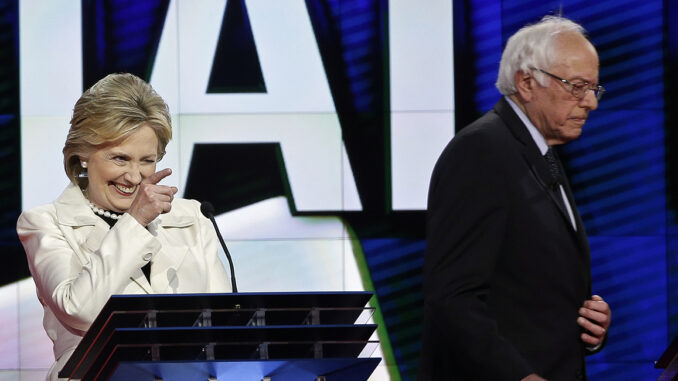
In 2009, a grassroots rebellion lit off upheaval so ferocious that the Grand Old Party was forced from cigar-smoking backrooms to Madison Square Garden MAGA rallies. It saw Eric Cantor, then House Majority Leader and the establishment’s golden boy, get primaried by an unknown economics professor. Marco Rubio forced Charlie Crist, the very embodiment of country club Republicanism, out of the party entirely. Less than a decade later, the unruly base would gleefully nominate Donald J. Trump for president — despite all establishment efforts to stop him.
The Tea Party wasn’t a controlled burn — it was a wildfire. John Boehner didn’t just lose his speakership; his entire worldview collapsed. Mitch McConnell survived only by adapting completely, culminating in the political gamble of keeping Supreme Court Justice Antonin Scalia’s seat open for Trump. And now he’s gone too.
The Democrats, on the other hand, are still led by the same faces that graced cable news in the Bush years. Nancy Pelosi handed the speaker’s gavel to Hakeem Jeffries, but the power structure remains unchanged. Chuck Schumer runs the Senate with the same playbook he used against George W. Bush. It’s like they’re running a political cover band, playing the greatest hits of 2006 to an increasingly dwindling crowd.
Just look at how they handled their own insurgents. The Squad arrived in Congress promising to be the left’s Tea Party. Instead, they got domesticated by the Democratic establishment. Alexandria Ocasio-Cortez went from storming Pelosi’s office to voting “present” on key votes. The radical rhetoric remained, but the genuine threat to power was contained. (Turns out it’s easier to get spots on magazine covers when you play nice with leadership.)
When Bernie Sanders emerged as their version of the Tea Party, the DNC suffocated him. Twice. They deployed every weapon, from superdelegate rules to strategic dropouts, ensuring the preferred candidate would prevail. The Democratic elite protected their power structure from the unruly mob, but at what cost?
The irony is almost too perfect: The party that prides itself on diversity and inclusion couldn’t tolerate diverse thoughts about its own future. They chose Kamala Harris, a candidate who checked all the right boxes on their diversity scorecard but failed to connect with the very voters those boxes were supposed to represent. (It turns out voters care more about their bank accounts than your DEI initiatives. Who knew? James Carville, for one.)
The Tea Party succeeded because it channeled genuine grassroots anger into political power. It was messy and embarrassing — but it worked, culminating in President Donald Trump. The Democratic leadership, by contrast, treats their base like a disruptive child: something to be managed and controlled, not heard and empowered.
The puzzle for Democratic reformation seems impossible. Their base is split between college-educated white progressives who dominate party machinery and working-class voters who feel increasingly alienated. The donor class demands fealty to corporate interests, while activists demand socialist revolution and to free Palestine. The DNC needs change but fears the chaos it requires.
What would a viable Democratic reformation look like? It would start by letting actual working-class candidates — not just ivory tower activists claiming to speak for them — primary incumbent Democrats without DNC interference. It would champion economic populism that speaks to union workers in Michigan as fluently as it does to tech workers in California. It would mean letting local (or national!) candidates break with party orthodoxy on issues like boys playing in girls’ sports or illegal migrants.
With Trump, the GOP establishment’s failure to stop him allowed for genuine transformation. When Bernie emerged, the Democratic establishment’s success in stopping him became their greatest failure. They maintained control but lost their soul (and a whole lot of voters, including Joe Rogan).
Now that Trump has won again, Democrats face an existential choice: enjoy the upheaval or continue with managed decline. They could learn from the Tea Party’s success — but that would require admitting that their opponents got something right, and we can’t have that, can we?
It took 15 years to transform the GOP from Boehner and Bush to Trump’s 2024 sweep. The last time the Democratic Party was this far behind was after Reagan vanquished Jimmy Carter in 1980, leaving Democrats wandering in the political wilderness until Bill Clinton emerged to save them 12 years later. This time, it’s not even clear that the Dems are aware of how lost they are.
The Tea Party taught Republicans to embrace chaos. The Democrats still think they can control it. Until that changes, they’ll keep losing to the very forces they refuse to understand — all while wondering why their perfect plans keep failing.
Barack Obama promised hope and change but delivered more of the same. Trump promised to burn it all down and actually did it. Maybe that’s the lesson Democrats need to learn: Sometimes you have to break your party to save it. Too bad they already neutered the guy who was trying to do just that.
Jordan Golson is a writer and commentator living outside Boston. He pens a car review column for North State Journal and oversees the paper’s local editions.



